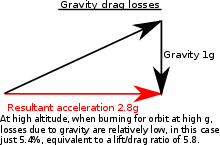Gravity drag
In astrodynamics and rocketry, gravity drag (or gravity losses) is a measure of the loss in the net performance of a rocket while it is thrusting in a gravitational field. In other words, it is the cost of having to hold the rocket up in a gravity field.
It is the difference between the delta-v expended and the theoretical delta-v for the actual change in speed and altitude, plus the delta-v for other losses such as air drag, that are experienced by a thrusting spacecraft.
Gravity losses depend on the time over which thrust is applied as well the direction the thrust is applied in. Gravity losses as a proportion of delta-v are minimised if maximum thrust is applied for a short time, or if thrust is applied in a direction perpendicular to the local gravitational field. During the launch and ascent phase, however, thrust must be applied over a long period with a major component of thrust in the opposite direction to gravity, so gravity losses become significant. For example, to reach a speed of 7.8 km/s in low Earth orbit requires a delta-v of between 9 and 10 km/s. The additional 1.5 to 2 km/s delta-v is due to gravity losses and atmospheric drag.
Example
Consider the simplified case of a vehicle with constant mass accelerating vertically with a constant thrust per unit mass a in a gravitational field of strength g. The actual acceleration of the craft is a-g and it is using delta-v at a rate of a per unit time.
Over a time t the change in speed of the spacecraft is (a-g)t, whereas the delta-v expended is at. The gravity drag is the difference between these figures, which is gt. As a proportion of delta-v, the gravity drag is g/a.
A very large thrust over a very short time will achieve a desired speed increase with little gravity drag. On the other hand, if a is only slightly greater than g, the gravity drag is a large proportion of delta-v. Gravity drag can be described as the extra delta-v needed because of not being able to spend all the needed delta-v instantaneously.
This effect can be explained in two equivalent ways:
- The specific energy gained per unit delta-v is equal to the speed, so efficiency is maximized when the delta-v is spent when the craft already has a high speed, due to the Oberth effect.
- Efficiency drops drastically with increasing time spent thrusting against gravity. Therefore, it is advisable to minimize the burn time.
These effects apply whenever climbing to an orbit with higher specific orbital energy, such as during launch to low Earth orbit (LEO) or from LEO to an escape orbit. This is a worst case calculation - in practice, gravity drag during launch and ascent is less than the maximum value of gt because the launch trajectory does not remain vertical and the vehicle's mass is not constant, due to consumption of propellant and staging.
Vector considerations

Thrust is a vector quantity, and the direction of the thrust has a large impact on the size of gravity losses. For instance, gravity drag on a rocket of mass m would reduce a 3mg thrust directed upward to an acceleration of 2g. However, the same 3mg thrust could be directed at such an angle that it had a 1mg upward component, completely canceled by gravity, and a horizontal component of mg× = 2.8mg (by Pythagoras' theorem), achieving a 2.8g horizontal acceleration.
As orbital speeds are approached, vertical thrust can be reduced as centrifugal force (in the rotating frame of reference around the center of the Earth) counteracts a large proportion of the gravitation force on the rocket, and more of the thrust can be used to accelerate.
It's important to note that minimising gravity losses is not the only objective of a launching spacecraft. Rather, the objective is achieve the position/velocity combination for the desired orbit. For instance, the way to maximize acceleration is to thrust straight downward; however, thrusting downward is clearly not a viable course of action for a rocket intending to reach orbit.
On a planet with an atmosphere, the objective is further complicated by the need to achieve the necessary altitude to escape the atmosphere, and to minimize the losses due to atmospheric drag during the launch itself. These facts sometimes inspire ideas to launch orbital rockets from high flying airplanes, to minimize atmospheric drag, and in a nearly horizontal direction, to minimize gravity losses.
See also
References
- Turner, Martin J. L. (2004), Rocket and Spacecraft Propulsion: Principles, Practice and New Developments, Springer, ISBN 978-3-540-22190-6.